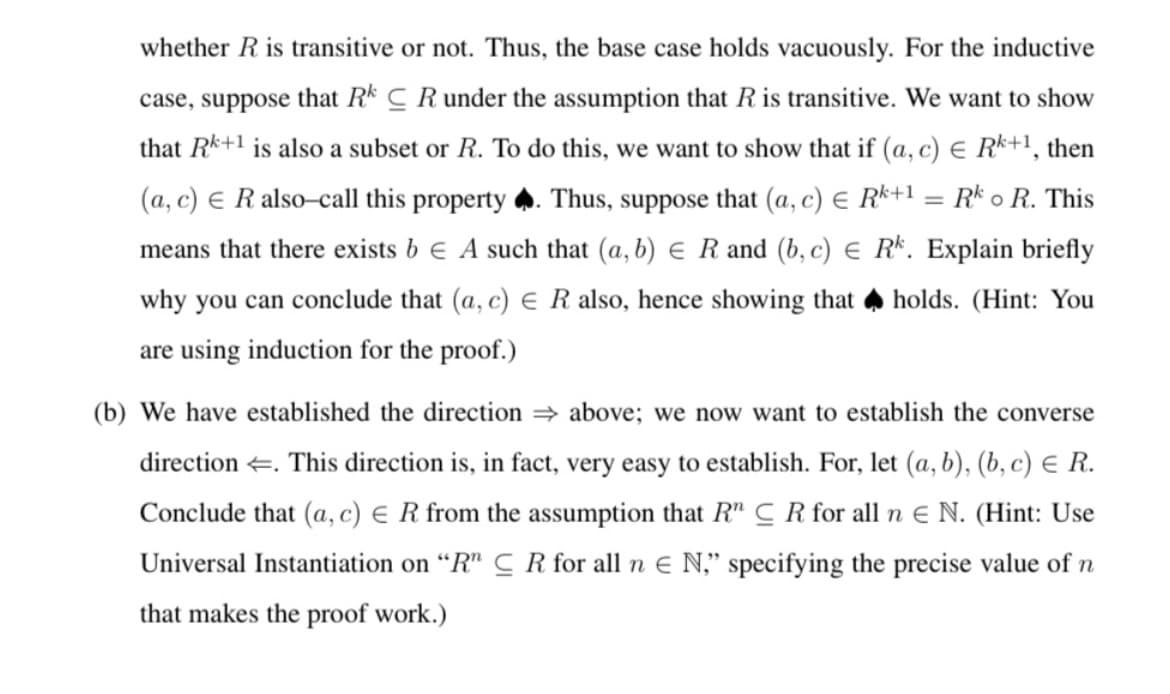In this exercise, you want to show that a relation RC A? is transitive + R"C R for all n E N = {1,2, 3, .}. Here is a step-by-step guide:
In this exercise, you want to show that a relation RC A? is transitive + R"C R for all n E N = {1,2, 3, .}. Here is a step-by-step guide:
Linear Algebra: A Modern Introduction
4th Edition
ISBN:9781285463247
Author:David Poole
Publisher:David Poole
Chapter4: Eigenvalues And Eigenvectors
Section4.6: Applications And The Perron-frobenius Theorem
Problem 17EQ
Related questions
Question

Transcribed Image Text:3.
In this exercise, you want to show that a relation R C A²
is transitive + R" C R for all n E N = {1,2,3, .}. Here is a step-by-step guide:
(a) We are going to establish the direction first. We accomplish this by induction on
n. For the base case, we have n = 1, but R' = RC R does not even depend on
%3D

Transcribed Image Text:whether R is transitive or not. Thus, the base case holds vacuously. For the inductive
case, suppose that Rk C R under the assumption that R is transitive. We want to show
that Rk+1 is also a subset or R. To do this, we want to show that if (a, c) E Rk+1, then
(a, c) E R also-call this property . Thus, suppose that (a, c) E R*+1 = R* o R. This
means that there exists b e A such that (a, b) E R and (b, c) € Rk. Explain briefly
why you can conclude that (a, c) E R also, hence showing that holds. (Hint: You
are using induction for the proof.)
(b) We have established the direction = above; we now want to establish the converse
direction +. This direction
in fact, very easy to establish. For, let (a, b), (b, c) E R.
Conclude that (a, c) € R from the assumption that R" C R for all n e N. (Hint: Use
Universal Instantiation on “R" C R for all n E N," specifying the precise value of n
that makes the proof work.)
Expert Solution
This question has been solved!
Explore an expertly crafted, step-by-step solution for a thorough understanding of key concepts.
Step by step
Solved in 3 steps with 3 images

Recommended textbooks for you

Linear Algebra: A Modern Introduction
Algebra
ISBN:
9781285463247
Author:
David Poole
Publisher:
Cengage Learning

Algebra & Trigonometry with Analytic Geometry
Algebra
ISBN:
9781133382119
Author:
Swokowski
Publisher:
Cengage

Elements Of Modern Algebra
Algebra
ISBN:
9781285463230
Author:
Gilbert, Linda, Jimmie
Publisher:
Cengage Learning,

Linear Algebra: A Modern Introduction
Algebra
ISBN:
9781285463247
Author:
David Poole
Publisher:
Cengage Learning

Algebra & Trigonometry with Analytic Geometry
Algebra
ISBN:
9781133382119
Author:
Swokowski
Publisher:
Cengage

Elements Of Modern Algebra
Algebra
ISBN:
9781285463230
Author:
Gilbert, Linda, Jimmie
Publisher:
Cengage Learning,

Elementary Linear Algebra (MindTap Course List)
Algebra
ISBN:
9781305658004
Author:
Ron Larson
Publisher:
Cengage Learning